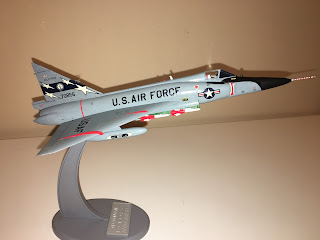It has been argued that the Hawker Hunter is the most beautiful jet aircraft ever built. I'm not sure about that, although it is quite aesthetic with a long fuselage bracketed by both curved and swept-back wings over large triangular air intakes. The Hawker Hunter was also one of the most successful British aircraft exports of the post-WW2 era, with almost 2,000 Hunters being build and used by in all 22 nations.
The FROG model is a late ground-attack version of the Hunter, the F.G.A.9, in this case armed with cannon and rocket pods. This kit is probably from the late 1960s or very early 1970s, and it is typical of FROG models of this era: thick, hard plastic, raised panel lines, but decent fit and accurate proportions. The kit comes with RAF and Swiss Air Force markings, and I chose the markings of a Hunter from No. 58 Squadron based at West Raynham around 1968. Painting was done with Vallejo colors, and the kit is built entirely out-of-the box while being seconded to Riga, Latvia. Further reviews can be found here:
https://modelingmadness.com/review/korean/previews/F207.htm
https://designer.home.xs4all.nl/models/hunter72/hunter72-main.htm




























































